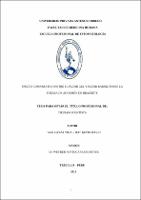Mostrar el registro sencillo del ítem
Efecto comparativo entre el flúor gel barniz sobre la fuerza de adhesión de brackets
| dc.contributor.advisor | Portocarrero Reyes Weyder | |
| dc.contributor.author | Layza Vidal, Jeff Kevin David | |
| dc.creator | Layza Vidal, Jeff Kevin David | |
| dc.date.accessioned | 2016-10-07T17:31:10Z | |
| dc.date.available | 2016-10-07T17:31:10Z | |
| dc.date.issued | 2015 | |
| dc.identifier.uri | https://hdl.handle.net/20.500.12759/1919 | |
| dc.description.abstract | El presente trabajo de investigación tuvo como objetivo comparar el efecto del flúor gel y el flúor barniz sobre la fuerza de adhesión de brackets. El estudio estuvo constituido por 36 premolares humanas en buen estado y con no más de seis meses de haber sido extraídas que fueron conservadas en suero fisiológico hasta el momento de la ejecución; las cuales fueron seleccionadas a través de un método no probabilístico por conveniencia con asignación aleatoria. Estos 36 premolares fueron distribuidos en tres grupos de 12 piezas dentarias cada uno, de los cuales en el primer grupo se utilizó el flúor barniz®, y en el segundo grupo se utilizó flúor barniz y en el tercer grupo no se utilizó flúor. La fuerza de adhesión se evaluó en tres días secuencialmente, para las piezas dentarias de cada grupo y se ejecutó en una máquina de Ensayos Humbolt® para medir la fuerza de adhesión de cada bracket sobre las piezas dentarias fluorizadas. Los valores obtenidos se registraron en Newton (resistencia al cizallamiento) y posteriormente se realizó la conversión a megapascales (MPa). Para el análisis estadístico se empleó la prueba de diferencia de medias, utilizando la distribución de t- Student, con un nivel de significancia de 5% (p < 0,05%). La prueba mostró que las piezas fluorizadas con barniz presentaron mayor fuerza de adhesión que en las que se utilizó flúor gel. | es_PE |
| dc.description.abstract | The present study has the purpose to compare the effect of fluoride gel and fluoride varnish on the bond strength of brackets. The study consisted of 36 human premolars in good condition with no more than six months have been taken that were preserved in saline at the time of execution; whom were selected through a non-probability method of convenience with random allocation. These 32 premolars were divided into three groups of 12 pieces teeth each; the first group used fluoride gel; the second group used fluoride varnish and the third without fluoride. The bond strength was evaluated in three days sequentially to the teeth of each group and executed in a Universal Testing Machine Humbolt® to measure the bond strength of each bracket on the teeth fluoridated. The values obtained are recorded in Newton (shear strength) and then converting to Megapascals (MPa) was performed. For statistical analysis, the mean difference test was employed, using the t -Student distribution, with a significance level of 5 % (p < 0.05%). The test showed that fluoridated varnish parts have stronger bond strength than teeth with fluoride gel. | en_US |
| dc.description.uri | Tesis | es_PE |
| dc.format | application/pdf | es_PE |
| dc.language.iso | spa | es_PE |
| dc.publisher | Universidad Privada Antenor Orrego - UPAO | es_PE |
| dc.relation.ispartofseries | T_ESTO_320 | |
| dc.rights | info:eu-repo/semantics/openAccess | es_PE |
| dc.source | Universidad Privada Antenor Orrego | es_PE |
| dc.source | Repositorio Institucional - UPAO | es_PE |
| dc.subject | Fuerza de adhesión | es_PE |
| dc.subject | Flúor | es_PE |
| dc.title | Efecto comparativo entre el flúor gel barniz sobre la fuerza de adhesión de brackets | es_PE |
| dc.type | info:eu-repo/semantics/bachelorThesis | es_PE |
| thesis.degree.level | Título Profesional | es_PE |
| thesis.degree.grantor | Universidad Privada Antenor Orrego. Facultad de Medicina Humana | es_PE |
| thesis.degree.name | Cirujano Dentista | es_PE |
| thesis.degree.discipline | Estomatología | es_PE |
Ficheros en el ítem
Este ítem aparece en la(s) siguiente(s) colección(es)
-
Estomatología [567]

